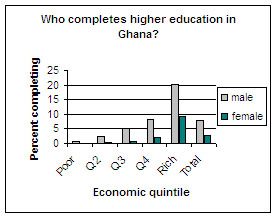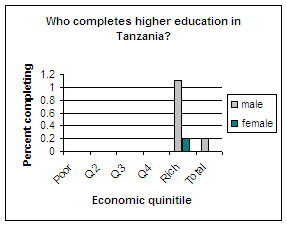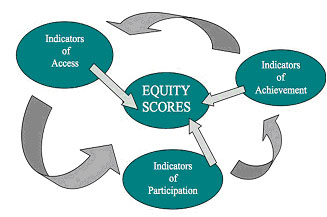Widening Participation and Poverty Reduction


Poverty reduction is the overarching concept which guides international commitments to development in the framework of the Millennium Development Goals (MDGs). The MDGs are already serving as a development framework and accepted benchmarks for many global and national initiatives for reform. Yet there have been few studies that explicitly relate the role of higher education to the achievement of the MDGs. In sub-Saharan Africa, employment opportunities have stagnated, and HIV/AIDS has taken a brutal toll on people in their most productive years. Poverty levels are increasing and armed conflict and hunger are still problems in the region.
How to accelerate economic growth and reduce poverty is a major policy issue for the governments of Ghana and Tanzania. Political and economic participation in society is essential for sustained poverty reduction, and enabling the poor to participate in emerging opportunities is crucial. Education, particularly higher education, has traditionally been one way to promote economic and political participation. Rapid enrolment growth has produced progress in many countries in access to education for traditionally less privileged groups, including students from rural areas and women. However, higher education generally remains elitist, with most students coming from wealthier segments of society.
One of the main determinants of inequity is family income, but, depending on the country, other factors contribute to unequal access and outcomes. These include caste, ethnicity, language, age, religion, regional origin, gender, and physical disability. Are equity interventions being extended to these and other socially disadvantaged groups?
The Equity Scorecard

The Equity Scorecard measures the extent to which access and participation in higher education is equitable. Based on a culture of evidence, the scorecard brings together diverse data on access, participation and achievement of socially and economically marginalised groups collected at each institution over a period of time. Central to the Equity Scorecard is disaggregation of institutional data. This allows the identification of critical gaps in recruitment, retention and achievement, with a view to action planning.
Life Histories
More textured understandings of enablers and barriers to participation and achievement in higher education were developed through life history interviews with 'non-traditional' students. These were focused on learner biographies in relation to social, economic and cultural backgrounds and networks, decision-making processes to enter higher education and previous and current educational experiences. They were asked to identify what factors helped or impeded their entry and achievement in higher education. The student sample reflected diversity in relation to gender, ethnicity, disability, religion, ethnicity/nationality/ language and age.
Semi-structured interviews with university staff in each case study institution and selected equity advocates explored individual experiences and views, instances of good practice and positive institutional initiatives on widening participation and poverty reduction.
Research capacity building
Research training was provided for lead researchers, research officers and local research teams in the life history method, software applications and data analysis with a view to cascading competences into the wider organisations and to succession planning. Also, throughout the project, members of the Sussex team visited the research sites to support research training, team development and dissemination.


